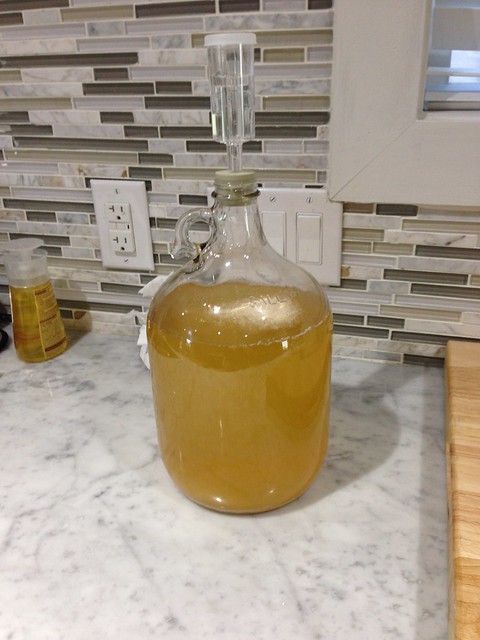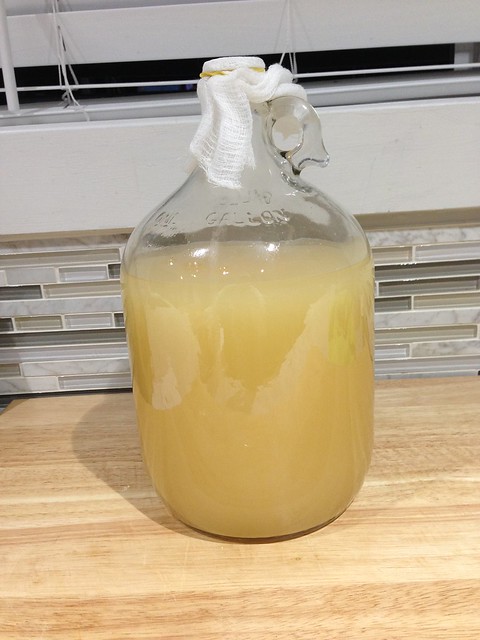AnnArrogance
Junior
- Joined
- Nov 19, 2014
- Messages
- 13
- Reaction score
- 3
Hello, all! So, I'm totally new to winemaking (but loving it so far) and have my first batch underway! I'm using a variation on the "Canny Apple Wine" recipe from "The Joy of Home Wine Making" by Terry Garey, but substituting passionfruit juice for the apple juice (hey, she does encourage you to experiment!). Basically, here's what I've got going on:
48 fl. oz. passionfruit juice
juice of 2 lemons
1 lb. 10 oz. sugar
water to 1 gallon
1 tsp. pectic enzyme
I'm using Montrachet yeast, since the recipe recommends it and it came with my starter kit setup rom my LHBS.
I bought Ceres 100% juice passionfruit juice, which contains only pear and passionfruit juices, and no preservatives or anything. After putting everything together I tested the PA/SG, and added 10 oz. of sugar (the recipe originally called for only 1 lb.) to bring the PA up to 12%. Also added 1.5 tsp. of acid blend to bring the acidity up to 0.60 per my acid test kit. I let it sit undisturbed for 24 hours before adding the yeast, which I just sprinkled on top per the recipe.
Here's a pic right after adding the yeast:

Now, here's where the questions come in. From everything I've read other than this one recipe (which is a beginner's recipe in the book, so I know she's trying to keep it simple), you should start your fermentation in a primary fermenter. This recipe says to put it all in a gallon carboy with a good amount of headspace and cover the top with plastic wrap and a rubber band, then rack and top up in a couple of weeks. I put in a bung and airlock instead, since I had one (the recipe presupposes you don't and tries to use minimal equipment), and figured that would let gas escape a bit better than plastic wrap.
Well, about 6 or 8 hours after adding my yeast, it looked like it was really starting up well. It was good and fizzy looking, and the airlock was bubbling like mad. 24 hours after adding the yeast, though, the bubbling had noticeably slowed down. I figured it wasn't getting enough air, so I removed the bung and airlock and put a piece of cheesecloth over the top of the carboy with a rubber band and gave everything a few good swirls. It fizzed like mad when I aerated it like that, but then settled back down. I also added 3/4 tsp. of SuperFerment yeast nutrient/energizer to be safe. I gave it a couple more good swirls throughout the day for good measure. I also wrapped the whole thing in a towel (leaving the top sticking out to breathe) for good measure thinking it might be a bit cold, although the stick-on thermometer on the bottle says it's between 70-73 degrees.
That was yesterday. Today (48 hours after adding the yeast), the must looks somewhat cloudier and there is some visible and audible fizzing, especially when I give it a swirl, but nothing like the foam or head I've seen online with most fermentations. Is that because I'm using just juice and not fermenting on the fruit or something, or do I have a slow/stuck fermentation? If so, should I transfer it to a primary fermenter or leave it be in the carboy? And again, if so, is there anything else I can do to perk it up?
Here's a pic of it today for comparison:

Sorry for the lengthy post and the newbie questions. Very excited about winemaking and hoping I haven't killed my passionfruit wine before it even had a chance! Also, feel free to tell me to chill out and be patient--I'm hoping winemaking will teach me patience eventually! Also, please forgive me and scold me harshly if I've posted this in the wrong place.
Also, please forgive me and scold me harshly if I've posted this in the wrong place.
48 fl. oz. passionfruit juice
juice of 2 lemons
1 lb. 10 oz. sugar
water to 1 gallon
1 tsp. pectic enzyme
I'm using Montrachet yeast, since the recipe recommends it and it came with my starter kit setup rom my LHBS.
I bought Ceres 100% juice passionfruit juice, which contains only pear and passionfruit juices, and no preservatives or anything. After putting everything together I tested the PA/SG, and added 10 oz. of sugar (the recipe originally called for only 1 lb.) to bring the PA up to 12%. Also added 1.5 tsp. of acid blend to bring the acidity up to 0.60 per my acid test kit. I let it sit undisturbed for 24 hours before adding the yeast, which I just sprinkled on top per the recipe.
Here's a pic right after adding the yeast:

Now, here's where the questions come in. From everything I've read other than this one recipe (which is a beginner's recipe in the book, so I know she's trying to keep it simple), you should start your fermentation in a primary fermenter. This recipe says to put it all in a gallon carboy with a good amount of headspace and cover the top with plastic wrap and a rubber band, then rack and top up in a couple of weeks. I put in a bung and airlock instead, since I had one (the recipe presupposes you don't and tries to use minimal equipment), and figured that would let gas escape a bit better than plastic wrap.
Well, about 6 or 8 hours after adding my yeast, it looked like it was really starting up well. It was good and fizzy looking, and the airlock was bubbling like mad. 24 hours after adding the yeast, though, the bubbling had noticeably slowed down. I figured it wasn't getting enough air, so I removed the bung and airlock and put a piece of cheesecloth over the top of the carboy with a rubber band and gave everything a few good swirls. It fizzed like mad when I aerated it like that, but then settled back down. I also added 3/4 tsp. of SuperFerment yeast nutrient/energizer to be safe. I gave it a couple more good swirls throughout the day for good measure. I also wrapped the whole thing in a towel (leaving the top sticking out to breathe) for good measure thinking it might be a bit cold, although the stick-on thermometer on the bottle says it's between 70-73 degrees.
That was yesterday. Today (48 hours after adding the yeast), the must looks somewhat cloudier and there is some visible and audible fizzing, especially when I give it a swirl, but nothing like the foam or head I've seen online with most fermentations. Is that because I'm using just juice and not fermenting on the fruit or something, or do I have a slow/stuck fermentation? If so, should I transfer it to a primary fermenter or leave it be in the carboy? And again, if so, is there anything else I can do to perk it up?
Here's a pic of it today for comparison:

Sorry for the lengthy post and the newbie questions. Very excited about winemaking and hoping I haven't killed my passionfruit wine before it even had a chance! Also, feel free to tell me to chill out and be patient--I'm hoping winemaking will teach me patience eventually!

















































![[Upgraded] 9Pcs Tree Root Growing Box with Drain Holes, Half Transparent Plant Rooting Propagation Ball & Metal Core Twist Ties, for Fast Propagation Plants (Size M)](https://m.media-amazon.com/images/I/514MWQxtWOL._SL500_.jpg)





